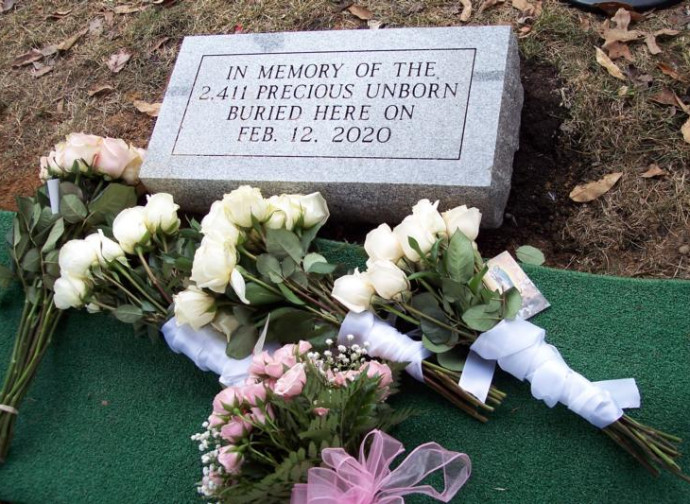Fetal burial: a warning to Europe from the US
After the Dobbs ruling, Planned Parenthood launched state-level campaigns to prevent the burial of foetuses: treating them differently from other hospital waste means considering them human beings. This is the front line in the battle for the "right" to abortion.

Sophocles’s Antigone is in many ways Europeans’ foundational charter of civil disobedience. To recap: Antigone defies the positive law of Creon, who decreed that her brother Polynices, who died in battle, be degraded by being left unburied, abandoned carrion for birds of prey. For performing funeral rites for her brother, Antigone was herself condemned to death. Antigone teaches that what we do with the dead is a measure of whom we are as the living. It’s a measure Europeans may soon find being taken, if American precedent has anything to say.
A local Ohio judge January 31 issued a temporary injunction, sought by Planned Parenthood, barring enforcement of that state’s law requiring that the remains of aborted unborn children be either interred or cremated. The genesis of the law lay in revelations that, prior to its initial proposal in 2020, fetal remains from abortion clinics were simply being dumped in landfills.
Ohio’s law is not unique. In neighboring Indiana, the state was in a prolonged fight in federal court over similar legislation – also against Planned Parenthood – that was initially signed by former Vice President Mike Pence when he was governor of that state. That legislation is now in force after a lower federal court judge initially blocked it.
Why the different outcomes? The Indiana case was fought while Roe v. Wade – with its guarantee of abortion-on-demand-through-birth – was binding U.S. jurisprudence. With the 2022 Dobbs decision overturning Roe, that federal constitutional claim no longer applied.
But, in the wake of Dobbs, abortion proponents have mobilized to re-create constitutional guarantees at the state level to replace Roe’s lost federal claim. In 2023, Ohio voters amended their state constitution to guarantee abortion-on-demand, effectively through birth.
Why should this matter to Europeans? Because after Dobbs was decided, no few European politicians clamored for enhanced legal protections of abortion on the continent. Emmanuel Macron was poster boy of the movement, having ushered through a French constitutional amendment to that end. Many members of the European Parliament have been demanding EU-wide legislation to “protect” the “right” to abortion (and punish a member state like Poland for its Constitutional Tribunal’s decision to strike down eugenically justified abortion). Some might even try to make “abortion rights” a “European value” of the sacred treaties or invent such a right at the European Court of Human Rights (ECHR). Given that the ECHR largely subscribes in human rights matters to what Americans would call a “living constitutionalism” – the meaning of the text to be interpreted “evolves” over time according to some mystical hermeneutic known but to human rights judges and their liberal NGO litigants – the possibility of inventing such a European “right” cannot be totally excluded.
Since Roe was decided in 1973, over 65 million abortions have taken place in the United States. The obvious Antigone question that should be asked – but largely isn’t – is: “where are the bodies?” Many certainly are not buried.
Many have been discarded. In the course of years of protests at abortion clinics – the kinds of protests Vice President J.D. defended in his Munich Security Council speech – prolife activists have also noticed what’s in the dumpster and what the “waste management” teams have picked up. Indeed, in 2022, at the height of President Biden’s lawfare against peaceful prolife protestors, Washington, D.C. investigators raided one of the activist’s homes, where she had retained a box obtained from a capital abortion clinic’s “waste management” services that contained the remains of five late term abortions.
While Biden feds prosecuted the abortion protestors for “obstructing access,” to date neither the federal nor district government has investigated whether those five bodies represented late-term abortions prohibited under federal law and whether the victims were actually born alive before dying. When Philadelphia abortionist Kermit Gosnell was convicted of murder (for cutting the spinal cords of newly-born, late term babies) and manslaughter (of a “patient”), prosecutors found that his home was a charnel house of pickled fetal remains.
Planned Parenthood has opposed fetal burial laws for a variety of red herring reasons: that it abridges an aborting woman’s freedom of religion and speech by forcing her to show respect towards fetal remains as if they were human and that the requirements impose unnecessary costs and psychological burdens on women that serve no “medical purpose” but advance a prolife position.
The truth is that these laws are red capes in front of bulls because, by suggesting fetal remains are different from, say, dental pulp at the orthodontist’s office or an appendix from the gastric surgery suite, it opens the question of fetal humanity. And, after having done their best through euphemisms to reduce the unborn child to “a blob of tissue” or a “clump of cells,” having to treat them any differently from other biohazard medical waste reopens a question abortionists want closed.
That’s not to say the humanity of those “blobs of tissue” cannot be humanized if there is money to be made from them. The same Planned Parenthood that sues Midwestern states for demanding fetal interment or cremation was caught on tape ten years ago conducting a lucrative trade in fetal body parts, with its abortionists were discussing how abortion procedures could be modified to ensure optimal extraction of lucrative fetal organs such as livers. Again, while California (initially led by Kamala Harris) sued the makers of those undercover videos rather than investigate the trafficking in body parts, it has just recently settled the case without the video producers’ conviction.
Abortion advocacy paradoxically tends to involve invoking extreme, hard cases in order to legitimize the average abortion procured for socio-economic reasons that many people viscerally find problematic but are willing to close their eyes to. But the resulting permissive abortion regimes raise questions such as what happens to the bodies and how their disposition might create at least cognitive dissonance with professed fidelity to the “value” at stake in “the right to abortion.” To the degree that Europeans succumb to pro-abortion sloganeering in their law, they need to ask themselves now, like Antigone once did: can we at least bury the bodies? Or do we leave them as carrion in landfills?




